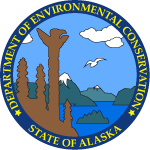| Action Date |
Action |
Description |
DEC Staff |
| 4/20/1990 |
Interim Removal Action Approved |
In a letter received 4/20/90 from Department of the Air Force, UST removal activity was summarized. While excavating footing for a new ALASCOM tower in 3/90, the contractor inadvertently struck piping associated with (2) diesel USTs which had provided fuel for an emergency electric generator. The USTs were installed in 1951. The USTs tested tight on 4/26/90, however, the piping was severely eroded and may have been leaking for some time. 300 cubic yards. of soils removed; depth of excavation to 14 feet. 14 soil samples taken from excavation; results in the letter. Analytical results received by Air Force; they state remediation of soils left in place is likely. |
Louis Howard |
| 7/12/1991 |
Site Ranked Using the AHRM |
Initial ranking. |
Louis Howard |
| 8/7/1991 |
Site Number Identifier Changed |
Workplan changed from "00" to"01" to reflect the fact UST providing fuel for back up generators not regulated and technically not a LUST. Old Reckey number 90210008102 changed to 90210108102 |
Louis Howard |
| 1/1/1992 |
Site Added to Database |
|
Louis Howard |
| 7/16/1993 |
Update or Other Action |
SERA Phase IB Site Assessment work plans received. Site ST72 is the location of reported contaminated soils believed to have been caused by a leaking UST pipe (Pollution Incident Report, 18 April 1990). This site is located on a hilltop on the north side of Building 42-500 and south of Ridge Road. Two diesel USTs were
removed from behind Building 42-500 in April 1990.
Building 42-500 was occupied by the Civil Air Patrol (CAP) in the mid-1970s, at which time both USTs were in use. In 1982, USAF reports indicated the tanks were filled with gravel and abandoned in place. In March 1990, a contractor struck the underground pipe that connected to the two USTs during excavation for a new antenna tower at the site. The contractors observed existing rusted pipe and made an assumption that the piping leaked prior to 1982. A visual inspection was made observing soil contamination in the area Construction was halted, and the Elmendorf AFB
Environmental Office and ADEC were notified of the leak.
Both USTs were leak tested in March 1990 and found to be leak-free (Pollution Incident Report, April 1990). The underground piping connected to the USTs was believed to be corroded. Further excavation and 14 soil samples collected from the excavation revealed soil contamination extending downward and laterally around the tanks. The soil contamination started at 3 feet and extended beyond 14 feet bgs, and extended around and beneath the tanks.
Both USTs and approximately 300 cubic yards of contaminated soil (to a depth of over 14 feet) were removed (Pollution Incident Report, April 1990). ADEC approved of the soil and tank
removal and backfilling of the hole. Based on the results of the soil samples taken at the site, extraction wells were considered an option as indicated by ADEC (Pollution Incident Report, April
1990) for removal of any remaining contamination.
The objectives of the ST72 site assessment are to:
* Incorporate existing data into a conceptual site model to assess potential crosscontamination from other contamination sources,
* Identify specific methods to identify useful data for the rapid follow-on design of in situ biological treatment process, and
* Obtain required SERA, paragraph 20A information.
Six soil borings will be placed in and around the ST72 release location,; three of the soil borings will be completed as monitoring wells. One boring will be drilled on each side of the suspected leak location to evaluate the vertical and horizontal extent of
hydrocarbon contamination. Borings will be drilled to groundwater, which is expected to be greater than 40 feet bgs based on previous investigations.
Three monitoring wells will be installed to assess water quality and evaluate if contaminated soil is contributing to groundwater contamination. One monitoring well will be installed upgradient of the leak location and two downgradient to evaluate if ST72 is a source of groundwater contamination, and to evaluate the groundwater gradient and flow direction in the area. Groundwater flow is assumed to be to the north in this location.
If soil contamination is found during field screening of soil borings, two additional borings will be drilled to further evaluate the extent of the contamination. The placement of the additional borings will be based on field observations and will be drilled after consultation with the 3rd CES/DEVR and ADEC representatives. |
John Halverson |
| 3/16/1994 |
Update or Other Action |
John Halverson ADEC sent letter to Dept. of Air Force, James Spell, Jr. 3 SPTG/CEVR RE: SERA Phase 1A and 1B; Site Assessment Report Final February 15, 1994. Overall the report is
acceptable as meeting the requirements for site assessments under the SERA. However, there are a few issues and recommendations in the report on which the department does not
concur. Below is a summary of the status of each of the sites. Areas of concern with the report are addressed along with requests for additional work where it was determined
necessary.
Sites Recommended for No Further Action- The final report recommended no further action on several of the sites. The following sites appear be suitable for such a decision: SS35; SS34; and, LF01. If the Air Force would like to pursue closure of these sites, the department requests submittal of a separate letter for each site requesting closure (similar to the August 31, 1992 closure letters used for other SERA sites). This would help clearly document no further action decisions.
Sites Recommended for No Further Action- However, Additional Work Requested. The report recommended closure of additional sites, however, based on the information provided to date, the department can not concur with the recommendations. Sites included in this category are listed below along with a brief discussion of additional work that is necessary and a request for work plans.
Sites with Recommendations for Additional Work-Based on the results of Phase I site assessment work the report recommends additional work at several sites. Each of these sites is listed below with a request for submittal of work plans.
ST72-Soil and groundwater contamination have been identified at the site. The report recommends additional groundwater monitoring and notes the site may be suitable for a small scale bioventing system. The department requests submittal of a corrective action plan for the site. |
John Halverson |
| 5/3/1995 |
Update or Other Action |
ADEC J. Halverson sent comment letter to USAF J. Williamson & C. Mayer 3 SUG/CEVR RE: Review Comments SERA Phase I Corrective Action Plan April 1995. General Comments-As noted in comments on the draft workplan, the corrective action plan needs to include schedules for conducting field work, monitoring and maintaining equipment, and submittal of interim and/or final corrective action reports. We have previously requested quarterly
reporting of remedial efforts at each site where free product has been identified (ST 43 and ST36).
The Air Force has proposed changes to the several of the tables that outline groundwater monitoring plans. Unless specifically noted below, the department does not object to these changes. The locations of substituted wells need to be shown on figures in the plan, if not already present.
ST72 - Leaking Tanks (Building 42-500, Civil Air Patrol & Alascom)
Section 2.7.3.2 - The modeling used to predict leaching of etroleum at the site was developed by ENSR and to our knowledge has not been through a peer review process.
In order to better evaluate the modeling results, the department requests that leaching modeling also be done with a peer reviewed model, such as Sesoil or a similar model. A degradation rate of 0.71 mg/kg-day was used based on a sensitivity analysis and comparison with modeling efforts at other sites on Elmendorf. However, the other sites are located in the outwash plain rather than the moraine deposits which are present at ST72. Due to the differences in hydrogeology, it is not clear that degradation rates would be similar.
The last paragraph, which describes compound type, appears to fit the site with regard to benzene concentrations. However, 1200 mg/kg DRO were measured at 52 feet bgs. It is not clear how the DRO will be addressed. An option would be to model some of the
individual diesel range organic constituents and calibrate the model to reflect leaching that has already occurred. |
John Halverson |
| 11/4/1996 |
Update or Other Action |
ADEC J. Halverson letter to USAF C. Mayer 3 SPTG/CEVR RE: SERA Projects-Decision Documents ST69 and ST72. Due to circumstances with the projects, the sites were not amenable to the simplest no-further-action decision process. Each site is addressed separately below.
ST72
A draft NFA decision document was submitted to us on April 18, 1996. The site was impacted by petroleum releases associated with an UST that stored diesel fuel. Subsequent assessment work documented diesel range organics (DRO) in soil. Up to 1200 mg/kg DRO was measured at a depth of 50 feet below the ground surface. Up to 200 micrograms per liter or parts per billion (ppb) DRO was measured in the groundwater. A leaching assessment was conducted and an alternative soil cleanup level of 1200 mg/kg was requested. The department verbally requested another water sample be collected from monitoring well 57 WL 03 to better determine whether groundwater contamination has occurred. Please forward copies of those test results as soon as they are available.
If the groundwater sample results, referred to above, support the proposed NFA decision, a revised decision document should be prepared with the following modifications:
1) Under the declaration section, the concentration of DRO measured in groundwater is stated as 200 parts per million (ppm). It should be changed to 200 ppb.
2) The top of the second page refers to low and localized concentrations of DRO. However, it should include information on the range of DRO concentrations measured in soil (from non-detectable concentrations up to 1200 ppm at 50 feet below ground surface) and should clarify that NFA decision would be based on an alternative soil cleanup level of 1200 ppm DRO in soil. |
John Halverson |
| 7/11/1998 |
Site Closure Approved |
Site closed out since levels of DRO were below level D action criteria.
The following policy applies for soil regulated under 18 AAC 75 and 18 AAC 78 that is proposed for disposal off site from where it was generated. If the following criteria is met, ADEC approval and/or an institutional control(s) are not required:
1. The soil meets the most stringent Method Two, Migration to Groundwater, Table B2 cleanup level, and the most stringent standards for those chemicals under Table B1;
2. The soil may only be disposed of at any non-environmentally sensitive location in the Under 40" or Over 40" annual precipitation zone;
3. The soil is not placed within 100 feet of water wells, surface waters, and drainage ditches; and
4.The written approval from the landowner of the off-site location is required.
The off site disposal of all other soil subject to the site cleanup rules that does not meet the criteria above shall be reviewed by the ADEC project manager in order to determine if the off-site disposal action poses a current or future risk to human health or the environment. The final approval to dispose of soil off site that does not meet the criteria shall be made by the ADEC Section Manager.
Terms used in this document have the meaning given in 18 AAC 75.990 including: “environmentally sensitive area” means a geographic area that, in the department's determination, is especially sensitive to change or alteration, including:
(A) an area of unique, scarce, fragile, or vulnerable natural habitat;
(B) an area of high natural productivity or essential habitat for living organisms;
(C) an area of unique geologic or topographic significance that is susceptible to a discharge;
(D) an area needed to protect, maintain, or replenish land or resources, including floodplains, aquifer recharge areas, beaches, and offshore sand deposits;
(E) a state or federal critical habitat, refuge, park, wilderness area, or other designated park, refuge, or preserve; and
(F) an area that merits special attention as defined at 6 AAC 80.170 (Repealed see AS 46.40.210(1))
“area which merits special attention” means a delineated geographic area within the coastal area which is sensitive to change or alteration and which, because of plans or commitments or because a claim on the resources within the area delineated would preclude subsequent use of the resources to a conflicting or incompatible use, warrants special management attention, or which, because of its value to the general public, should be identified for current or future planning, protection, or acquisition; these areas, subject to council definition of criteria for their identification, include:
(A) areas of unique, scarce, fragile or vulnerable natural habitat, cultural value, historical significance, or scenic importance;
(B) areas of high natural productivity or essential habitat for living resources;
(C) areas of substantial recreational value or opportunity;
(D) areas where development of facilities is dependent upon the utilization of, or access to, coastal water;
(E) areas of unique geologic or topographic significance which are susceptible to industrial or commercial development;
(F) areas of significant hazard due to storms, slides, floods, erosion, or settlement; and
(G) areas needed to protect, maintain, or replenish coastal land or resources, including coastal flood plains, aquifer recharge areas, beaches, and offshore sand deposits. |
Louis Howard |
| 7/13/1998 |
Exposure Tracking Model Ranking |
Initial ranking with ETM completed for source area id: 71914 name: auto-generated pm edit Elmendorf ST72 Bldg 16322 |
Louis Howard |




